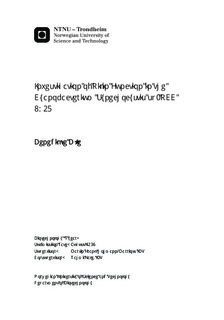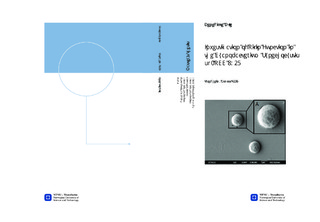| dc.description.abstract | The aim of this project was to investigate the involvement of a specific operon from Synechocystis sp. PCC 6803 (hereafter Synechocystis 6803) in iron acquisition. The operon selected consists of the four genes, slr1928, slr1929, slr1930 and slr1931 (slr1928-31), all hypothesized to encode pilin-like proteins (Yoshihara et al., 2001). Bacterial pili are demonstrated to function as so-called nanowires, through which the organism may donate electrons to extracellular acceptors (Gorby et al., 2006). In this way pili might contribute to iron uptake by facilitating reduction of ferric iron. Pilin-like proteins related to the operon slr1928-31 appear to contribute to iron uptake (Gorby et al., 2006; Singh et al., 2003), leading to the hypothesis that the operon slr1928-31 may possess similar functions. In order to determine the potential functions of slr1928-31, a mutant strain lacking the operon was produced. Assessment of differences between cultures where the operon was present (wild type, WT) and absent (mutant strain, Δ slr1928-31-Kan) was performed by testing growth of both strains under various conditions. Different iron sources (ferric ammonium citrate - Fac, iron (II, III) oxide - FeO, ferric chloride hexahydrate - FeCl, goethite - Goe and potassium hexacyanoferrate (III) - Hexacyan) were supplied to the medium to test their utility in the presence or absence of the operon slr1928-31. Different nutrient supplements (glucose) or treatments with stress-inducing chemicals (DCMU or NaCl) were tested to induce different modes of growth. The effects of the mutation were also examined by two spectroscopic methods, (I) 77 K fluorescence spectroscopy and (II) whole-cell room temperature absorption spectroscopy. The growth assay showed few differences in growth between WT and Δ slr1928-31-Kan cultures on media without NaCl but generally better growth for the mutant strain on media with NaCl (except for the DCMU condition). The results from both whole cell absorption spectroscopy and 77 K fluorescence spectroscopy corresponded with these results: The main differences between WT and Δ slr1928-31-Kan strains were seen on medium with NaCl or with NaCl and glucose, for which WT cultures on FeCl under the former condition and WT cultures on Fac, FeCl or Hexacyan under the latter condition had too little growth for spectroscopic analysis. Otherwise the differences occurred mainly between the iron sources. The most clear indications of stress were observed for samples grown on Goe, suggesting that this was the most challenging iron source to utilize. Additionally, the relative availability of the iron sources tested seemed to change with addition of NaCl to the medium, possibly inducing precipitation of iron from the water-soluble sources and consequently better growth on water-insoluble iron sources in the presence of NaCl. No function of the slr1928-31 gene products in iron acquisition was detected in this study. Whether or not this operon has a minor or indirect role in iron uptake under some circumstances remains to be established. These pilin-like proteins could also have a regulatory function, possibly initiated in response to iron stress. According to the results of this work, the mutant strain Δ slr1928-31-Kan appears to be less stressed than the WT strain under some high-NaCl conditions. This outcome suggests that the operon slr1928-31 might be involved in salt-sensory mechanisms and/or responses to stress such as high NaCl concentrations in the growth medium. Growth under stress may serve as a framework in which the function of pilin-like proteins encoded by the operon slr1928-31 should be further investigated. | nb_NO |

